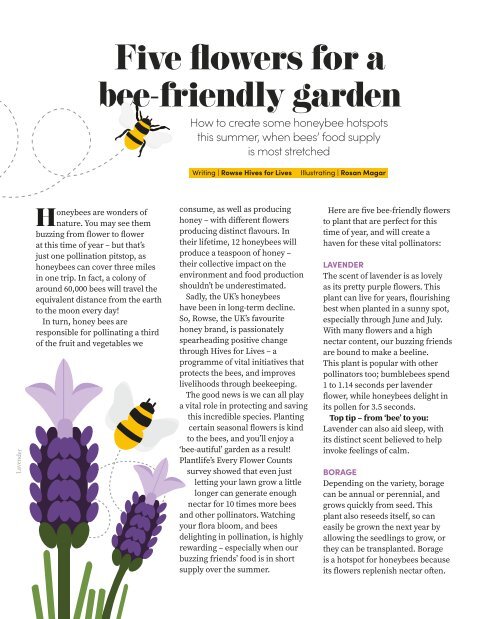Create successful ePaper yourself
Turn your PDF publications into a flip-book with our unique Google optimized e-Paper software.
Five flowers for a<br />
bee-friendly garden<br />
How to create some honeybee hotspots<br />
this summer, when bees’ food supply<br />
is most stretched<br />
Writing | Rowse Hives for Lives<br />
Illustrating | Rosan Magar<br />
Lavender<br />
Honeybees are wonders of<br />
nature. You may see them<br />
buzzing from flower to flower<br />
at this time of year – but that’s<br />
just one pollination pitstop, as<br />
honeybees can cover three miles<br />
in one trip. In fact, a colony of<br />
around 60,000 bees will travel the<br />
equivalent distance from the earth<br />
to the moon every day!<br />
In turn, honey bees are<br />
responsible for pollinating a third<br />
of the fruit and vegetables we<br />
consume, as well as producing<br />
honey – with different flowers<br />
producing distinct flavours. In<br />
their lifetime, 12 honeybees will<br />
produce a teaspoon of honey –<br />
their collective impact on the<br />
environment and food production<br />
shouldn’t be underestimated.<br />
Sadly, the UK’s honeybees<br />
have been in long-term decline.<br />
So, Rowse, the UK’s favourite<br />
honey brand, is passionately<br />
spearheading positive change<br />
through Hives for Lives – a<br />
programme of vital initiatives that<br />
protects the bees, and improves<br />
livelihoods through beekeeping.<br />
The good news is we can all play<br />
a vital role in protecting and saving<br />
this incredible species. Planting<br />
certain seasonal flowers is kind<br />
to the bees, and you’ll enjoy a<br />
‘bee-autiful’ garden as a result!<br />
Plantlife’s Every Flower Counts<br />
survey showed that even just<br />
letting your lawn grow a little<br />
longer can generate enough<br />
nectar for 10 times more bees<br />
and other pollinators. Watching<br />
your flora bloom, and bees<br />
delighting in pollination, is highly<br />
rewarding – especially when our<br />
buzzing friends’ food is in short<br />
supply over the summer.<br />
Here are five bee-friendly flowers<br />
to plant that are perfect for this<br />
time of year, and will create a<br />
haven for these vital pollinators:<br />
LAVENDER<br />
The scent of lavender is as lovely<br />
as its pretty purple flowers. This<br />
plant can live for years, flourishing<br />
best when planted in a sunny spot,<br />
especially through June and July.<br />
With many flowers and a high<br />
nectar content, our buzzing friends<br />
are bound to make a beeline.<br />
This plant is popular with other<br />
pollinators too; bumblebees spend<br />
1 to 1.14 seconds per lavender<br />
flower, while honeybees delight in<br />
its pollen for 3.5 seconds.<br />
Top tip – from ‘bee’ to you:<br />
Lavender can also aid sleep, with<br />
its distinct scent believed to help<br />
invoke feelings of calm.<br />
BORAGE<br />
Depending on the variety, borage<br />
can be annual or perennial, and<br />
grows quickly from seed. This<br />
plant also reseeds itself, so can<br />
easily be grown the next year by<br />
allowing the seedlings to grow, or<br />
they can be transplanted. Borage<br />
is a hotspot for honeybees because<br />
its flowers replenish nectar often.

















